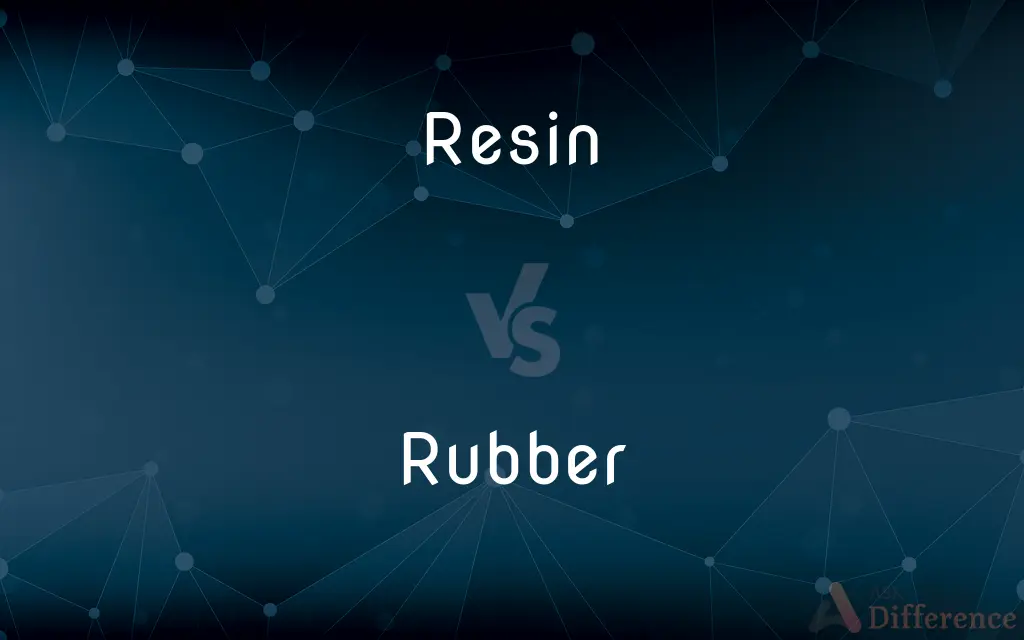Resin vs. Rubber — What's the Difference?
By Fiza Rafique & Urooj Arif — Updated on March 21, 2024
Resin is a sticky, viscous substance secreted by plants or synthesized, used in varnishes and adhesives, while rubber is an elastic material made from the latex of certain plants or synthesized, used in tires and seals.

Difference Between Resin and Rubber
Table of Contents
ADVERTISEMENT
Key Differences
Resin and rubber are both important materials with distinct properties and applications. Resin, derived from plant secretions or created synthetically, is known for its adhesive qualities and rigidity once cured. It is widely used in the production of varnishes, adhesives, and as a component in composite materials. On the other hand, rubber is celebrated for its elasticity and durability, originating from the latex of rubber trees or produced synthetically. Its applications range from automotive tires to waterproof seals and insulating materials.
The source of resin can be natural, such as pine sap, or synthetic, created through chemical processes. Natural resins have been used historically for sealing, perfumery, and medicine. Synthetic resins, like epoxy and polyester, are tailored for specific strengths and durability, essential in construction, automotive, and aerospace industries. Conversely, rubber's natural form is harvested from the latex of specific plants, with Hevea brasiliensis being a primary source. Synthetic rubber is manufactured from petrochemicals, offering attributes like resistance to heat and chemicals that natural rubber lacks.
Resin's versatility extends beyond adhesives to include roles in art, where it's used for casting and coating to create durable and aesthetically pleasing finishes. Rubber's flexibility and resilience make it indispensable in products requiring shock absorption, flexibility, and water resistance. These differences underscore rubber's role in dynamic applications, such as in the movement and protection of various goods and machinery, contrasting resin's primary use in static, supportive roles.
The environmental impact of both materials varies. Natural resin is biodegradable and renewable, but its synthetic counterpart can be less eco-friendly due to its petrochemical origins. Natural rubber, while renewable, poses ecological concerns when plantations contribute to deforestation. Synthetic rubber's production involves fossil fuels, raising sustainability and pollution issues. However, advances in recycling and bio-based production methods are addressing these environmental challenges for both materials.
Despite their differences, both resin and rubber have synthetic versions, reflecting humanity's quest for materials with specific properties like enhanced durability, resistance to elements, and application-specific flexibility. The development of synthetic variants illustrates the overlap in the evolution of materials science, aiming to meet diverse industrial and consumer needs.
ADVERTISEMENT
Comparison Chart
Source
Plant secretions or synthetic chemicals.
Latex of certain plants or synthetic materials.
Properties
Sticky, viscous, hardens upon curing.
Elastic, flexible, durable.
Primary Use
Varnishes, adhesives, composite materials.
Tires, seals, elastic products.
Types
Natural (e.g., amber, pine resin) and synthetic (e.g., epoxy, polyester).
Natural (from rubber trees) and synthetic (from petrochemicals).
Environmental Impact
Variable; natural resins are biodegradable, synthetic can be less eco-friendly.
Renewable but can contribute to deforestation; synthetic variants impact due to fossil fuel use.
Compare with Definitions
Resin
Resin is a sticky substance used in making varnishes and adhesives.
The artist mixed pigment into the resin for the sculpture.
Rubber
Rubber is an elastic material used in tires and various products.
The rubber tires provide smooth rides and good traction.
Resin
Can be natural or synthetic, serving various industrial applications.
Epoxy resin is used for its strong adhesive properties in boat building.
Rubber
Used in products requiring flexibility and shock absorption.
Rubber mats are used in gyms for their shock-absorbent properties.
Resin
Used in art for its clear, durable finish.
Resin coatings give paintings a glossy, protective finish.
Rubber
Essential for waterproofing and sealing.
Rubber seals are used in faucets to prevent leaks.
Resin
Natural resins include amber and rosin.
Amber, fossilized tree resin, is prized in jewelry making.
Rubber
Synthetic rubber includes neoprene and styrene-butadiene.
Neoprene rubber is used in wetsuits for its thermal and water-resistant properties.
Resin
Essential in manufacturing composite materials.
Carbon fiber composites use resin to bond fibers for strength.
Rubber
Derived from the latex of rubber trees or synthetically produced.
Natural rubber is harvested by tapping into the bark of rubber trees.
Resin
In polymer chemistry and materials science, resin is a solid or highly viscous substance of plant or synthetic origin that is typically convertible into polymers. Resins are usually mixtures of organic compounds.
Rubber
A tough elastic polymeric substance made from the latex of a tropical plant or synthetically
A rubber plantation
A rubber dinghy
Heat and sunlight may cause rubber to deteriorate
Resin
A sticky flammable organic substance, insoluble in water, exuded by some trees and other plants (notably fir and pine)
Clear resin had oozed to the surface, trickled down, and set
Rubber
A piece of rubber used for erasing pencil or ink marks
A pencil with a rubber at the end
Resin
A solid or liquid synthetic organic polymer used as the basis of plastics, adhesives, varnishes, or other products
Epoxy resins frequently cause dermatitis
The chassis is constructed of synthetic resin
Rubber
Rubber boots; galoshes.
Resin
Rub or treat with resin
Resined canvas
Rubber
A condom.
Resin
Any of numerous clear to translucent yellow or brown, solid or semisolid, viscous substances of plant origin, such as copal, rosin, and amber, used principally in lacquers, varnishes, inks, adhesives, plastics, and pharmaceuticals. Resins are usually insoluble in water.
Rubber
A contest consisting of a series of successive matches (typically three or five) between the same sides or people in cricket, tennis, and other games
The opening rubber of Britain's Davis Cup tie against Argentina
Resin
Any of numerous physically similar polymerized synthetics or chemically modified natural resins including thermoplastic materials such as polyvinyl, polystyrene, and polyethylene and thermosetting materials such as polyesters, epoxies, and silicones that are used with fillers, stabilizers, pigments, and other components to form plastics.
Rubber
A yellowish, amorphous, elastic material, composed almost entirely of an isoprene polymer, obtained from the milky sap or latex of various tropical plants, especially the rubber tree, and vulcanized, pigmented, finished, and modified into products such as electric insulation, elastic bands and belts, tires, and containers. Also called caoutchouc, India rubber.
Resin
To treat or rub with resin.
Rubber
Any of numerous synthetic elastic materials of varying chemical composition with properties similar to those of natural rubber; an elastomer.
Resin
A viscous hydrocarbon secretion of many plants, particularly coniferous trees.
Rubber
A low overshoe made of rubber.
Resin
Any of various yellowish viscous liquids or soft solids of plant origin; used in lacquers, varnishes and many other applications; chemically they are mostly hydrocarbons, often polycyclic.
Rubber
(Baseball) The rectangular piece of hard rubber that the pitcher must remain in contact with when making a pitch.
Resin
Any synthetic compound of similar properties.
Rubber
An eraser.
Resin
(transitive) To apply resin to.
Rubber
A tire.
Resin
Any one of a class of yellowish brown solid inflammable substances, of vegetable origin, which are nonconductors of electricity, have a vitreous fracture, and are soluble in ether, alcohol, and essential oils, but not in water; specif., pine resin (see Rosin).
Rubber
A set of tires on a vehicle.
Resin
Any of various polymeric substance resembling the natural resins[1], prepared synthetically; - they are used, especially in particulate form, in research and industry for their property of specifically absorbing or adsorbing substances of particular types; they are especially useful in separation processes such as chromatography; as, an ion-exchange resin.
Rubber
(Slang) A condom.
Resin
Any of a class of solid or semisolid viscous substances obtained either as exudations from certain plants or prepared by polymerization of simple molecules
Rubber
One that rubs, especially one that gives a massage.
Rubber
A series of games of which two out of three or three out of five must be won to terminate the play.
Rubber
An odd game played to break a tie.
Rubber
(uncountable) Pliable material derived from the sap of the rubber tree; a hydrocarbon polymer of isoprene.
Rubber
Synthetic materials with the same properties as natural rubber.
Rubber
An eraser.
Rubber
A condom.
Rubber
(countable) Someone or something which rubs.
Rubber
One who rubs down horses.
Rubber
One who practises massage.
Rubber
A coarse towel for rubbing the body.
Rubber
An abrasive for rubbing with: a whetstone, file, or emery cloth, etc.
Rubber
(historical) The cushion of an electric machine.
Rubber
The rectangular pad on the pitcher's mound from which the pitcher must pitch.
Jones toes the rubber and then fires to the plate.
Rubber
Water-resistant shoe covers, galoshes, overshoes.
Johnny, don't forget your rubbers today.
Rubber
Tires, particularly racing tires.
Jones enters the pits to get new rubber.
Rubber
A hardship or misfortune.
Rubber
(sports) In relation to a series of games or matches between two competitors where the overall winner of the series is the competitor which wins a majority of the individual games or matches:
Rubber
The entire series, of an odd number of games or matches in which ties are impossible (especially a series of three games in bridge or whist).
Rubber
An individual match within the series (especially in racquet sports).
Rubber
A rubber match; a game or match played to break a tie.
Rubber
The game of rubber bridge.
Rubber
Not covered by funds on account.
Rubber
(telephony) To eavesdrop on a telephone call
Rubber
(slang) To rubberneck; to observe with unseemly curiosity.
Rubber
One who, or that which, rubs.
Rubber
In some games, as bridge or whist, the odd game, as the third or the fifth, which decides the winner when there is a tie between the players; as, to play the rubber; also, a contest determined by the winning of two out of three games; as, to play a rubber of whist.
Rubber
India rubber; caoutchouc; gum elastic; - also called natural rubber.
Rubber
Any substance, whether natural or synthetic, resembling India rubber with respect to its elasticity[1].
Rubber
A low-cut overshoe made of natural or synthetic rubber[4], serving to keep the feet and shoes dry when walking in the rain or on a wet surface; - usually used in the plural.
Rubber
A condom.
Rubber
Latex from trees (especially trees of the genera Hevea and Ficus)
Rubber
An eraser made of rubber (or of a synthetic material with properties similar to rubber); commonly mounted at one end of a pencil
Rubber
Contraceptive device consisting of a thin rubber or latex sheath worn over the penis during intercourse
Rubber
A waterproof overshoe that protects shoes from water or snow
Rubber
Coat or impregnate with rubber;
Rubberize fabric for rain coats
Rubber
Made of rubber and therefore water-repellent;
Rubber boots
Rubber
Returned for lack of funds;
A rubber check
A no-good check
Common Curiosities
How are resin and rubber used in everyday products?
Resin is found in varnishes, adhesives, and art, while rubber is used in tires, seals, and products requiring flexibility and durability.
What makes rubber elastic?
Rubber's elasticity comes from its polymer structure, allowing it to stretch and return to its original shape.
Can resin be used in jewelry?
Yes, resin is popular in jewelry making for its versatility and ability to encapsulate objects.
How is rubber different from resin?
Rubber is elastic and durable, made from plant latex or synthetically, used in tires and seals, contrasting resin's sticky, viscous nature used in static applications.
Can both resin and rubber be synthetic?
Yes, both materials have synthetic versions, developed for specific properties and applications.
Are there eco-friendly alternatives to synthetic resin and rubber?
Yes, bio-based resins and rubbers are being developed to reduce environmental impact, focusing on sustainability and biodegradability.
Why is natural rubber preferred in some applications?
Natural rubber is often preferred for its superior elasticity and biodegradability in environmentally conscious applications.
Is rubber recyclable?
Yes, rubber can be recycled, though the process and efficiency vary depending on the type of rubber and the recycling technology.
What is resin?
Resin is a sticky substance from plants or synthetically made, used in varnishes, adhesives, and composites.
How is synthetic rubber made?
Synthetic rubber is produced through chemical processes, often involving the polymerization of petrochemicals.
What are the environmental impacts of resin and rubber?
The environmental impact varies; natural resins and rubbers are renewable but can have ecological footprints, while their synthetic counterparts involve petrochemicals, affecting sustainability.
What role does resin play in composite materials?
Resin binds the fibers in composite materials, providing strength, durability, and resistance to environmental factors.
What are the advantages of synthetic over natural rubber?
Synthetic rubber offers enhanced properties like oil, heat, and chemical resistance, making it suitable for specific industrial applications.
How do temperature changes affect rubber and resin?
Rubber maintains its elasticity within a temperature range, while resin can become more brittle or softer with temperature changes, affecting their applications.
Share Your Discovery

Previous Comparison
Theodolite vs. Transit
Next Comparison
Acknowledged vs. AcknowledgeAuthor Spotlight
Written by
Fiza RafiqueFiza Rafique is a skilled content writer at AskDifference.com, where she meticulously refines and enhances written pieces. Drawing from her vast editorial expertise, Fiza ensures clarity, accuracy, and precision in every article. Passionate about language, she continually seeks to elevate the quality of content for readers worldwide.
Co-written by
Urooj ArifUrooj is a skilled content writer at Ask Difference, known for her exceptional ability to simplify complex topics into engaging and informative content. With a passion for research and a flair for clear, concise writing, she consistently delivers articles that resonate with our diverse audience.














































